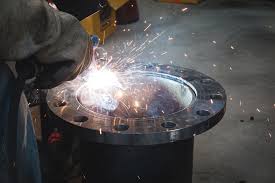Pad flanges, also known as reinforcing pads, play a critical role in providing additional support and strength to pipe connections. Regular inspection and maintenance are essential to ensure these flanges function correctly and to prevent system failures. This article outlines the steps and techniques involved in inspecting and maintaining pad flanges, ensuring optimal performance and safety.

1. “Learn more about Pad flange guide.”
Importance of Inspecting and Maintaining Pad Flanges
Regular inspection and maintenance of pad flanges offer several key benefits:
- Prevents Failures: Early detection of potential issues helps prevent failures and leaks.
- Ensures Safety: Proper maintenance enhances the safety of the piping system.
- Extends Lifespan: Regular upkeep prolongs the lifespan of the flanges and the overall system.
- Compliance: Adherence to industry standards and regulations is maintained through proper inspection and maintenance.
Common Issues with Pad Flanges
Understanding the common issues that can affect pad flanges is crucial for effective inspection and maintenance.
Corrosion
Corrosion is a major issue that can compromise the integrity of pad flanges.
- Causes: Exposure to corrosive environments, such as chemicals, moisture, and saltwater.
- Effects: Weakens the flange material, leading to potential leaks and failures.
Cracks and Fractures
Cracks and fractures can develop due to stress, fatigue, or improper installation.
- Causes: Mechanical stress, thermal cycling, and welding defects.
- Effects: Compromise the structural integrity of the flange, leading to possible failure.
Wear and Erosion
Wear and erosion occur due to the continuous flow of abrasive materials through the piping system.
- Causes: Abrasive fluids, high flow rates, and turbulent flow conditions.
- Effects: Thinning of the flange material, leading to reduced strength and potential leaks.
Steps for Inspecting Pad Flanges
A systematic approach to inspecting pad flanges ensures thorough evaluation and early detection of issues.
Visual Inspection
Visual inspection is the first step in identifying obvious defects and anomalies.
- Surface Examination: Check for visible signs of corrosion, cracks, and wear on the flange surface.
- Weld Inspection: Inspect the welds for any signs of defects, such as porosity, cracks, and undercuts.
- Alignment Check: Ensure the flange and piping are properly aligned, and there are no signs of misalignment or distortion.
Non-Destructive Testing (NDT)
NDT methods are used to detect internal defects without damaging the flanges.
- Ultrasonic Testing (UT): Uses high-frequency sound waves to detect internal flaws and measure material thickness.
- Radiographic Testing (RT): Utilizes X-rays or gamma rays to produce images of the flange’s internal structure, revealing defects.
- Magnetic Particle Testing (MPT): Applies magnetic particles to the flange surface to detect surface and slightly subsurface defects.
Dimensional Inspection
Dimensional inspection ensures the flange dimensions meet the required tolerances.
- Measurement Tools: Use calipers, micrometers, and gauges to measure the flange dimensions accurately.
- Tolerance Check: Compare the measurements with the specified tolerances to ensure compliance.
Pressure Testing
Pressure testing verifies the flange’s ability to withstand the operating pressure.
- Hydrostatic Testing: Fills the piping system with water and pressurizes it to check for leaks and structural integrity.
- Pneumatic Testing: Uses air or gas to pressurize the system, suitable for applications where water contamination must be avoided.
Steps for Maintaining Pad Flanges
Regular maintenance practices help keep pad flanges in optimal condition and prevent issues.
Cleaning
Regular cleaning prevents the accumulation of dirt, debris, and corrosive substances.
- Cleaning Methods: Use brushes, solvents, and high-pressure water jets to clean the flange surfaces.
- Inspection After Cleaning: Perform a visual inspection after cleaning to detect any hidden defects.
Corrosion Protection
Applying protective coatings and treatments helps prevent corrosion.
- Coatings: Apply anti-corrosion coatings, such as epoxy or galvanization, to protect the flange surface.
- Cathodic Protection: Use cathodic protection systems to prevent corrosion in buried or submerged flanges.
Lubrication
Lubrication ensures smooth operation and prevents wear in moving parts.
- Lubricants: Use appropriate lubricants for bolts, nuts, and other moving parts in the flange assembly.
- Frequency: Lubricate at regular intervals as specified by the manufacturer or industry standards.
Bolt Tightening and Replacement
Proper bolt tightening and timely replacement ensure secure connections.
- Torque Wrench: Use a torque wrench to tighten bolts to the specified torque values.
- Bolt Inspection: Regularly inspect bolts for signs of wear, corrosion, and damage, and replace as necessary.
Monitoring and Record Keeping
Regular monitoring and maintaining detailed records help track the condition of pad flanges over time.
- Inspection Logs: Keep detailed logs of all inspections, tests, and maintenance activities.
- Monitoring Systems: Use monitoring systems to track pressure, temperature, and other critical parameters in real-time.
FAQs
Why is regular inspection of pad flanges important?
Regular inspection helps detect potential issues early, preventing failures and ensuring the safety and reliability of the piping system.
What are common issues found during pad flange inspections?
Common issues include corrosion, cracks, wear, and erosion, which can compromise the integrity of the flange.
What non-destructive testing methods are used for pad flange inspection?
Common NDT methods include ultrasonic testing, radiographic testing, and magnetic particle testing.
How can I protect pad flanges from corrosion?
Applying protective coatings, using cathodic protection systems, and regular cleaning can help protect pad flanges from corrosion.
Why is lubrication important for pad flanges?
Lubrication ensures smooth operation of bolts and nuts, preventing wear and ensuring secure connections.
What should be included in inspection and maintenance logs?
Logs should include details of all inspections, tests, maintenance activities, and any issues detected, along with the corrective actions taken.
Conclusion
Regular inspection and maintenance of pad flanges are essential for ensuring the reliability and safety of industrial piping systems. By understanding the common issues, following systematic inspection steps, and implementing effective maintenance practices, industries can enhance the performance and longevity of their piping systems. Proper upkeep of pad flanges not only prevents failures and extends their lifespan but also ensures compliance with industry standards and regulations. visit: https://www.texasflange.com/
